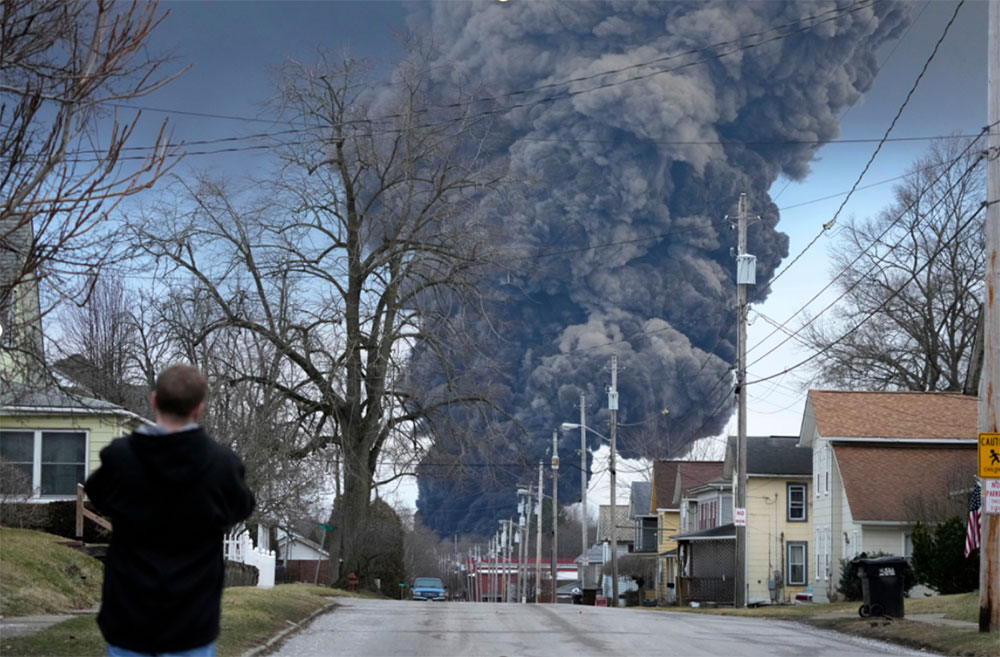Rethinking the applications of PVC in the Built Environment
As the charred remains of homes and cars stand as reminders of the wildfires’ devastation—the impact of their destruction lingers, releasing toxic debris and hazardous chemicals into surrounding neighborhoods and endangering public health.
This is alarming, because the basic building block of PVC is a known human carcinogen that has been linked to rare liver cancers in exposed workers 4
The Environmental and Health Dangers of PVC
PVC poses serious environmental and health dangers throughout its entire life cycle – from manufacture to installation, daily use, and end-of-life disposal or fires. Below is an overview of how PVC releases toxic chemicals at each stage and the associated long-term impacts:
Manufacturing (Production)
PVC is produced from vinyl chloride monomer, a carcinogenic chemical. While certain safety measures have improved, U.S. PVC factories still collectively emitted over 400,000 pounds of vinyl chloride into the air in 2021, affecting communities in Louisiana, Texas, and other states. These emissions contribute to the phenomenon of “Cancer Alley” in petrochemical regions and exemplify how PVC production creates toxic pollution. The locations of many vinyl plants in low-income or minority communities also raises environmental justice concerns5.
Installation and Use (Occupancy)
Once PVC products are in buildings, they continue to impact indoor environmental quality. Many PVC building materials are formulated with a “witch’s brew” of toxic additives5. For example, flexible vinyl flooring, wall coverings, and cables often contain phthalate plasticizers – chemicals that gradually off-gas into indoor air and dust. Studies have found that exposure to these materials is associated with elevated risk of asthma, wheezing, and even pneumonia 6. These health hazards illuminate the need for low-VOC finishes and PVC-free furnishings to improve indoor air quality.
Fire and Heat Incidents
The most acute hazard of PVC occurs if it burns. When PVC combusts, it releases large quantities of hydrogen chloride (HCl) gas, which forms corrosive hydrochloric acid upon contact with moisture (such as in human airways). In controlled fire tests, burning PVC pipe produced HCl concentrations hundreds of times above safe limits – reaching over 700 ppm, versus a 1 ppm public health guideline. This toxic smoke is extremely dangerous to building occupants and first responders; inhalation of HCl and other combustion byproducts (like dioxins, hydrogen cyanide, and carbon monoxide) can be quickly fatal or cause lasting lung damage7.
Firefighters have warned that the widespread use of plastic (especially PVC) in modern buildings has introduced new deadly smoke hazards during fires. Beyond immediate toxicity, noxious soot from burning PVC can settle on surfaces and remain for months1, as seen in the aftermath of urban wildfires. The residue may contain persistent organic pollutants, including dioxins, that continue to expose people long after the fire. In summary, PVC dramatically increases the toxic potency of any building fire, both in the smoke and the post-fire environment.

Disposal (Landfill and Incineration)
At end of life, PVC is one of the least sustainable building materials. It is rarely recycled in practice (well under 1% of PVC is ever recycled8 due to contamination and technical challenges, so most PVC building waste ends up in landfills or is incinerated. Landfilled PVC can leach additives into soil and groundwater over time.)
If burned in waste incinerators or uncontrolled fires, PVC generates dioxins, a group of the most potent and persistent toxic chemicals known. Dioxins bioaccumulate in the food chain and have been linked to cancers, immune system damage, and birth defects5. Incinerators and open burning of PVC waste often impact nearby communities (again raising environmental justice issues like the production phase).
Today’s cheap PVC building product becomes tomorrow’s hazardous waste problem – one that can linger for generations. This full life-cycle perspective reveals why PVC is sometimes called “the poison plastic,” and why numerous public health organizations have called for reducing or phasing it out.
The real challenge:
The dilemma of PVC in the building industry lies in its well-documented environmental and health hazards versus its relatively low embodied carbon, affordability and ease of installation compared to alternatives. Despite its toxicity, longevity, and contribution to pollution, PVC remains widely used because replacing it with materials like aluminum or cast iron often results in even higher carbon emissions. In 2007, USGBC considered a PVC avoidance credit but did not implement it due to these trade-offs. Today, with embodied carbon as a top industry priority—given its immediate impact on global warming—materials must not only outperform PVC in health and sustainability but also compete on carbon footprint.
Considering these challenges, the need to replace PVC in building applications through a holistic evaluation is necessary. Part II explores practical alternatives for common PVC uses, focusing on materials that improve health, safety, and sustainability without sacrificing performance.
Resources:
- https://www.sciencenews.org/article/toxic-danger-lurk-burn-los-angeles-fire#:~:text=Even%20as%20firefighters%20douse%20the,blanketed%20parts%20of%20the%20region
- https://ww3.rics.org/uk/en/journals/built-environment-journal/plastics-construction-materials-health.html#:~:text=The%20construction%20industry%20consumes%2020,predicted%20to%20double%20by%202050
- https://metropolismag.com/products/what-can-we-do-about-pvc/#:~:text=Yet%20PVC%20rules,%E2%80%9D
- https://wwwn.cdc.gov/TSP/ToxFAQs/ToxFAQsDetails.aspx?faqid=281&toxid=51#:~:text=The%20U,cause%20cancer
- https://www.sierraclub.org/sierra/environment-explained/plastic-pvc-polyvinyl-chloride-buildings-not-fantastic#:~:text=some%20regards%2C%20reducing%20emissions%20and,New%20Jersey%20with%20toxic%20loads
- https://eldonjames.com/wp-content/uploads/2017/08/Dangers-of-PVC.pdf?srsltid=AfmBOorkRojpo8P0CF_HAAhKTNgcyuoTtjs58EgHZzFp9KHKNUdJVRS0#:~:text=,HBN
- https://safepipingmatters.org/2019/09/23/study-in-fires-toxic-smoke-from-plastic-can-doom-occupants/#:~:text=Test%20,hydrogen%20chloride%20reached%20909%20ppm
- https://clkrep.lacity.org/onlinedocs/2011/11-0923_misc_b_11-20-12.pdf#:~:text=Points%20clkrep.lacity.org%20%20,products%20or%20PVC%20waste
